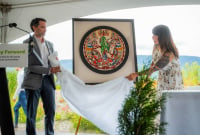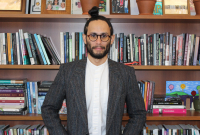Support strong Canadian climate journalism for 2025
In 2018, Joe Bailey was running a successful tourism business showing guests the colourful Aurora Borealis. Then, the COVID-19 pandemic locked down the Northwest Territories.
The territory was shut off from the rest of the world for two years, which meant no revenue for Bailey’s business, NorthStar Adventures, except government funding.
His business received some federal grants, but the territorial government waited more than a year before dispensing funds to struggling operations.
Now, four years later, Bailey has had to sell almost all his assets, including five vans and 12 snowmobiles, hobbling his business for the foreseeable future. Coming out of the pandemic, the once thriving adventure company was left with only one van. But now, more domestic visitors are arriving to see the northern lights again.
“We’re in rebuilding mode, with a very slow tour season,” said Bailey. “So we're definitely nowhere near the numbers before COVID… but it really forced us to be much more savvy with our business decisions and our business practices.”
Indigenous tourism businesses faced barriers accessing government support over the pandemic, despite suffering from “disproportionately negative impacts” of the travel restrictions and economic chaos of that time, according to internal documents obtained by Canada’s National Observer through access-to-information legislation.
Internal documents from Innovation, Science and Economic Development Canada reveal that Indigenous tourism faced difficulties even though Ottawa has celebrated its pandemic-era business support as a “powerful tool” in Canada’s reconciliation efforts.

Statistics from the pandemic show that Indigenous tourism was harder hit than the rest of the sector. The Indigenous tourism industry saw an estimated 65.9 per cent decline in direct GDP and a 59.4 per cent drop in employment in 2020 due to the pandemic, according to numbers from ITAC that were quoted in the internal documents. By comparison, tourism GDP as a whole declined 50.1 per cent and total employment declined by 21.1 per cent that same year.
Indigenous tourism had difficulties meeting the federal program’s financial requirements, and faced challenges with program applications and eligibility requirements that may disproportionately exclude Indigenous businesses, such as unincorporated, community-owned and non-taxable businesses, the internal documents show.
Bailey also points to a discrepancy between Indigenous and non-Indigenous businesses.
For example, Indigenous businesses need more professional support getting into the industry, Bailey explained.
“Indigenous entrepreneurs are at a disadvantage,” Bailey said. “So funding and programs for the first timers would go a long way to help grow and succeed Indigenous tourism in Canada.”
During the pandemic, tourism businesses across Canada were devastated, said Keith Henry, president and CEO of the Indigenous Tourism Association of Canada (ITAC), but Indigenous businesses were the “hardest of the hardest hit.”
Their smaller scale in rural and remote locations, which became more difficult to access, made Indigenous operations particularly vulnerable.
Darcie Guarderas, director and client strategist for Tansi Tourism Solutions, often works with Indigenous tour operators on a one-on-one basis. She had a call with another Indigenous business owner in the Northwest Territories whose operation didn’t survive the pandemic, even though it was at its peak.
“He wants to get back [to] what he's doing because he has the passion for it, but they need more support,” Guarderas said, noting that many operators leave the industry for more steady work.
“When you're a small business with not a lot of funding, you know, [the pandemic] just crushed them,” she told Canada’s National Observer.
One in three international visitors expressed interest in Indigenous tourism, according to a 2021 survey by Destination Canada. Travel magazines also identified Indigenous tourism as a trend for 2023, according to the internal documents.
“At present, projections point to a strong decade of growth globally for the sector, as the World Travel and Tourism Council projects that travel and tourism GDP will outpace the growth of the overall economy by more than two times,” the documents found.
Bailey’s business operated almost exclusively for international guests seeing the Aurora Borealis. Now, more domestic tourism is arriving in Yellowknife, while the international audience continues to rebuild.
However, it wasn’t just a pandemic problem. The document revealed there is “evidence of a gap in international travelers' awareness of Indigenous tourism offerings in Canada.”
Henry is not surprised and argues that Ottawa is failing to meaningfully invest in his industry.
“The bottom line is we don't have the investment structures yet to really continue to tap into the potential of what could be there,” he said. “That takes marketing and development and we don’t have that reality in our [sector] yet.”
Guardaras, for example, points to airports as the “ground zero” for creating awareness of Indigenous tourism. And yet, only Vancouver, Winnipeg and Edmonton do a good job of telling visitors that they are landing in Indigenous territory. That’s not the case for other provinces.
Henry argues development and marketing will require “real investments” into Indigenous tourism from the federal and provincial governments, as well as from the larger tourism sector.
“I'm beyond listening to lip service,” he said.
In a statement to Canada’s National Observer, Alexander Cohen, director of communications for Tourism Minister Soraya Martinez Ferrada, , acknowledged that Indigenous tourism has the power to advance reconciliation and self-determination.
“That’s why supporting the growth of Indigenous tourism is one of our top priorities, in close partnership with Indigenous leaders,” the statement added. “It’s important to emphasize that communities make their own decisions and do tourism at their own pace. We must respect that.”
Matteo Cimellaro / Canada’s National Observer / Local Journalism Initiative







Comments